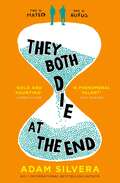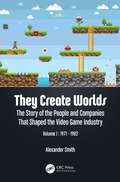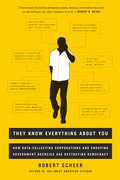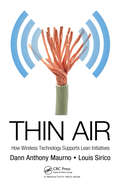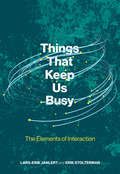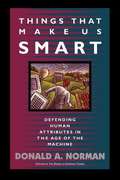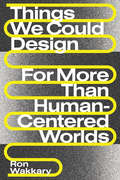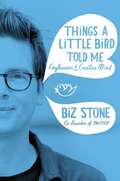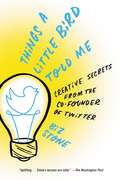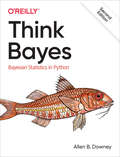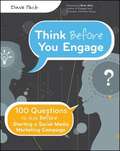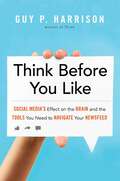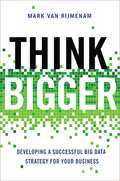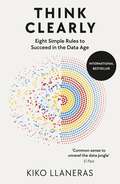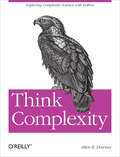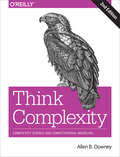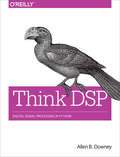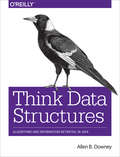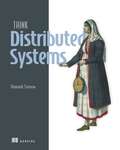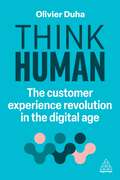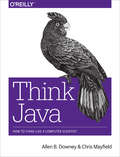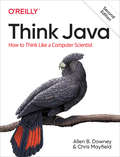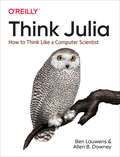- Table View
- List View
They Both Die at the End: The Uk No. 1 Bestseller!
by Adam Silvera<P>From the bestselling author of HISTORY IS ALL YOU LEFT ME comes another unforgettable story of life, loss and making each day count <P>On September 5th, a little after midnight, Death-Cast calls Mateo Torrez and Rufus Emeterio to give them some bad news: they're going to die today. Mateo and Rufus are total strangers, but, for different reasons, they're both looking to make a new friend on their End Day. The good news: there's an app for that. It's called the Last Friend, and through it, Rufus and Mateo are about to meet up for one last great adventure - to live a lifetime in a single day. <P><b>A New York Times Bestseller</b>
They Both Die at the End: TikTok made me buy it! (They Both Die at the End series)
by Adam SilveraThe first book in the No. 1 global bestselling They Both Die at the End series. What if you could find out your death date from a single phone call? Death-Cast is calling . . . will you answer? &‘If They Both Die at the End broke your heart and put it back together again, be prepared for this novel to do the same. A tender, sad, hopeful and youthful story that deserves as much love as its predecessor.&’ Culturefly '[A] heart-pounding story [full] of emotion and suspense.' Kirkus 'An extraordinary book with a riveting plot.' BooklistA love story with a difference - an unforgettable tale of life, loss and making each day count. On September 5th, a little after midnight, Death-Cast calls Mateo Torrez and Rufus Emeterio to give them some bad news: they're going to die today. Mateo and Rufus are total strangers, but, for different reasons, they're both looking to make a new friend on their End Day. The good news: there's an app for that. It's called the Last Friend, and through it, Rufus and Mateo are about to meet up for one last great adventure - to live a lifetime in a single day. Another beautiful, heartbreaking and life-affirming book from the brilliant Adam Silvera, author of More Happy Than Not, History Is All You Left Me, What If It's Us, Here's To Us and the Infinity Cycle series.PRAISE FOR ADAM SILVERA: 'There isn't a teenager alive who won't find their heart described perfectly on these pages.' Patrick Ness, author of The Knife of Never Letting Go 'Adam Silvera is a master at capturing the infinite small heartbreaks of love and loss and grief.' Nicola Yoon, author of Everything, Everything 'A phenomenal talent.' Juno Dawson, author of Clean and Wonderland 'Bold and haunting.' Lauren Oliver, author of Delirium
They Create Worlds: The Story of the People and Companies That Shaped the Video Game Industry, Vol. I: 1971-1982
by Alexander SmithThey Create Worlds: The Story of the People and Companies That Shaped the Video Game Industry, Vol. 1 is the first in a three-volume set that provides an in-depth analysis of the creation and evolution of the video game industry. Beginning with the advent of computers in the mid-20th century, Alexander Smith’s text comprehensively highlights and examines individuals, companies, and market forces that have shaped the development of the video game industry around the world. Volume one, places an emphasis on the emerging ideas, concepts, and games developed from the commencement of the budding video game art form in the 1950s and 1960s through the first commercial activity in the 1970s and early 1980s. They Create Worlds aims to build a new foundation upon which future scholars and the video game industry itself can chart new paths. Key Features: The most in-depth examination of the video game industry ever written, They Create Worlds charts the technological breakthroughs, design decisions, and market forces in the United States, Europe, and East Asia that birthed a $100 billion industry. The books derive their information from rare primary sources such as little-studied trade publications, personal papers collections, and oral history interviews with designers and executives, many of whom have never told their stories before. Spread over three volumes, They Create Worlds focuses on the creative designers, shrewd marketers, and innovative companies that have shaped video games from their earliest days as a novelty attraction to their current status as the most important entertainment medium of the 21st Century. The books examine the formation of the video game industry in a clear narrative style that will make them useful as teaching aids in classes on the history of game design and economics, but they are not being written specifically as instructional books and can be enjoyed by anyone with a passion for video game history.
They Know Everything About You: How Data-Collecting Corporations and Snooping Government Agencies Are Destroying Democracy
by Robert Scheer Sara BeladiThey Know Everything About You is a groundbreaking exposé of how government agencies and tech corporations monitor virtually every aspect of our lives, and a fierce defense of privacy and democracy. The revelation that the government has access to a vast trove of personal online data demonstrates that we already live in a surveillance society. But the erosion of privacy rights extends far beyond big government. Intelligence agencies such as the NSA and CIA are using Silicon Valley corporate partners as their data spies. Seemingly progressive tech companies are joining forces with snooping government agencies to create a brave new world of wired tyranny. Life in the digital age poses an unprecedented challenge to our constitutional liberties, which guarantee a wall of privacy between the individual and the government. The basic assumption of democracy requires the ability of the individual to experiment with ideas and associations within a protected zone, as secured by the Constitution. The unobserved moment embodies the most basic of human rights, yet it is being squandered in the name of national security and consumer convenience. Robert Scheer argues that the information revolution, while a source of public enlightenment, contains the seeds of freedom’s destruction in the form of a surveillance state that exceeds the wildest dream of the most ingenious dictator. The technology of surveillance, unless vigorously resisted, represents an existential threat to the liberation of the human spirit.
Thin Air: How Wireless Technology Supports Lean Initiatives
by Dann Anthony Maurno Louis SiricoAlthough Lean and wireless professionals seek the same goals, few are fluent in each other‘s language. Those who are have already helped their companies tap into the competitive advantages possible by integrating wireless technology into a Lean culture of continuous process improvement. Highlighting wireless as a powerful and inherently Lean tool,
Things That Keep Us Busy: The Elements of Interaction (The\mit Press Ser.)
by Erik Stolterman Lars-Erik JanlertAn investigation of interactivity, interfaces and their design, and the webs of complex interactions that result.We are surrounded by interactive devices, artifacts, and systems. The general assumption is that interactivity is good—that it is a positive feature associated with being modern, efficient, fast, flexible, and in control. Yet there is no very precise idea of what interaction is and what interactivity means. In this book, Lars-Erik Janlert and Erik Stolterman investigate the elements of interaction and how they can be defined and measured. They focus on interaction with digital artifacts and systems but draw inspiration from the broader, everyday sense of the word.Viewing the topic from a design perspective, Janlert and Stolterman take as their starting point the interface, which is designed to implement the interaction. They explore how the interface has changed over time, from a surface with knobs and dials to clickable symbols to gestures to the absence of anything visible. Janlert and Stolterman examine properties and qualities of designed artifacts and systems, primarily those that are open for manipulation by designers, considering such topics as complexity, clutter, control, and the emergence of an expressive-impressive style of interaction. They argue that only when we understand the basic concepts and terms of interactivity and interaction will we be able to discuss seriously its possible futures.
Things That Make Us Smart: Defending Human Attributes in the Age of the Machine
by Donald NormanHumans have always worked with objects to extend our cognitive powers, from counting on our fingers to designing massive supercomputers. But advanced technology does more than merely assist with thought and memory.
Things We Could Design: For More Than Human-Centered Worlds (Design Thinking, Design Theory)
by Ron WakkaryHow posthumanist design enables a world in which humans share center stage with nonhumans, with whom we are entangled.Over the past forty years, designers have privileged human values such that human-centered design is seen as progressive. Yet because all that is not human has been depleted, made extinct, or put to human use, today's design contributes to the existential threat of climate change and the ongoing extinctions of other species. In Things We Could Design, Ron Wakkary argues that human-centered design is not the answer to our problems but is itself part of the problem. Drawing on philosophy, design theory, and numerous design works, he shows the way to a relational and expansive design based on humility and cohabitation. Wakkary says that design can no longer ignore its exploitation of nonhuman species and the materials we mine for and reduce to human use. Posthumanism, he argues, enables a rethinking of design that displaces the human at the center of thought and action. Weaving together posthumanist philosophies with design, he describes what he calls things--nonhumans made by designers--and calls for a commitment to design with more than human participation. Wakkary also focuses on design as "nomadic practices"--a multiplicity of intentionalities and situated knowledges that shows design to be expansive and pluralistic. He calls his overall approach "designing-with": the practice of design in a world in which humans share center stage with nonhumans, and in which we are bound together materially, ethically, and existentially.
Things a Little Bird Told Me: Confessions of the Creative Mind
by Biz StoneBiz Stone, the co-founder of Twitter, discusses the power of creativity and how to harness it, through stories from his remarkable life and career. THINGS A LITTLE BIRD TOLD ME From GQ's "Nerd of the Year" to one of Time's most influential people in the world, Biz Stone represents different things to different people. But he is known to all as the creative, effervescent, funny, charmingly positive and remarkably savvy co-founder of Twitter-the social media platform that singlehandedly changed the way the world works. Now, Biz tells fascinating, pivotal, and personal stories from his early life and his careers at Google and Twitter, sharing his knowledge about the nature and importance of ingenuity today. In Biz's world: * Opportunity can be manufactured * Great work comes from abandoning a linear way of thinking * Creativity never runs out * Asking questions is free * Empathy is core to personal and global success. In this book, Biz also addresses failure, the value of vulnerability, ambition, and corporate culture. Whether seeking behind-the-scenes stories, advice, or wisdom and principles from one of the most successful businessmen of the new century, THINGS A LITTLE BIRD TOLD ME will satisfy every reader.
Things a Little Bird Told Me: Confessions of the Creative Mind
by Biz StoneBiz Stone, the co-founder of Twitter, discusses the power of creativity and how to harness it, through stories from his remarkable life and career.THINGS A LITTLE BIRD TOLD MEFrom GQ's "Nerd of the Year" to one of Time's most influential people in the world, Biz Stone represents different things to different people. But he is known to all as the creative, effervescent, funny, charmingly positive and remarkably savvy co-founder of Twitter-the social media platform that singlehandedly changed the way the world works. Now, Biz tells fascinating, pivotal, and personal stories from his early life and his careers at Google and Twitter, sharing his knowledge about the nature and importance of ingenuity today. In Biz's world:-Opportunity can be manufactured-Great work comes from abandoning a linear way of thinking-Creativity never runs out -Asking questions is free-Empathy is core to personal and global success In this book, Biz also addresses failure, the value of vulnerability, ambition, and corporate culture. Whether seeking behind-the-scenes stories, advice, or wisdom and principles from one of the most successful businessmen of the new century, THINGS A LITTLE BIRD TOLD ME will satisfy every reader.
Think Bayes
by Allen B. DowneyIf you know how to program with Python and also know a little about probability, you're ready to tackle Bayesian statistics. With this book, you'll learn how to solve statistical problems with Python code instead of mathematical notation, and use discrete probability distributions instead of continuous mathematics. Once you get the math out of the way, the Bayesian fundamentals will become clearer, and you'll begin to apply these techniques to real-world problems.Bayesian statistical methods are becoming more common and more important, but not many resources are available to help beginners. Based on undergraduate classes taught by author Allen Downey, this book's computational approach helps you get a solid start.Use your existing programming skills to learn and understand Bayesian statisticsWork with problems involving estimation, prediction, decision analysis, evidence, and hypothesis testingGet started with simple examples, using coins, M&Ms, Dungeons & Dragons dice, paintball, and hockeyLearn computational methods for solving real-world problems, such as interpreting SAT scores, simulating kidney tumors, and modeling the human microbiome.<P><P> Advisory: Bookshare has learned that this book offers only partial accessibility. We have kept it in the collection because it is useful for some of our members. To explore further access options with us, please contact us through the Book Quality link on the right sidebar. Benetech is actively working on projects to improve accessibility issues such as these.
Think Bayes: Bayesian Statistics In Python
by Allen B. DowneyIf you know how to program, you're ready to tackle Bayesian statistics. With this book, you'll learn how to solve statistical problems with Python code instead of mathematical formulas, using discrete probability distributions rather than continuous mathematics. Once you get the math out of the way, the Bayesian fundamentals will become clearer and you'll begin to apply these techniques to real-world problems.Bayesian statistical methods are becoming more common and more important, but there aren't many resources available to help beginners. Based on undergraduate classes taught by author Allen B. Downey, this book's computational approach helps you get a solid start.Use your programming skills to learn and understand Bayesian statisticsWork with problems involving estimation, prediction, decision analysis, evidence, and Bayesian hypothesis testingGet started with simple examples, using coins, dice, and a bowl of cookiesLearn computational methods for solving real-world problems
Think Before You Engage
by Dave PeckBe sure you've addressed the most important questions before using social media to market your company or brand!From small business owners to job seekers, social media marketing campaigns are being started every day. However, without the proper prep work, campaigns fail, brands or organizations are impacted, customers are not engaged, and money and efforts are wasted. This invaluable guide answers all the most important questions to consider before starting a marketing campaign using social media so you can avoid common pitfalls.Social media guru and author David Peck presents you with a working knowledge of the different social media tools that are needed to effectively embark on a social media marketing campaign.Guides you through defining goals, setting up a web site, using pertinent social networks, linking sites together, building a community, and monitoring progressFeatures numerous real-world stories that offer unique insight on what to do and what not to doShares simple tips for developing a web site with no code requiredSifts through the enormous amount of social media available and helps you select which is most appropriate for your needsAddresses how to locate and engage people and then keep them coming backAnswering a plethora of common questions, this book shows you how to engage your customers with social media in a way that will keep them coming back for more.
Think Before You Like: Social Media's Effect on the Brain and the Tools You Need to Navigate Your Newsfeed
by Guy P. HarrisonAt a time when the news cycle turns on a tweet, journalism gets confused with opinion, and facts are treated as negotiable information, applying critical thinking skills to your social media consumption is more important than ever. Guy P. Harrison, an upbeat advocate of scientific literacy and positive skepticism, demonstrates how critical thinking can enhance the benefits of social media while giving users the skills to guard against its dangers. Social media has more than two billion users and continues to grow. Its widespread appeal as a means of staying in touch with friends and keeping up with daily news masks some serious pitfalls-- misinformation, pseudoscience, fraud, propaganda, and irrational beliefs, for example, presented in an attractive, easy-to-share form. This book will teach you how to resist the psychological and behavioral manipulation of social media and avoid the mistakes that millions have already made and now regret. Harrison presents scientific studies that show why your subconscious mind loves social media and how that can work against your ability to critically evaluate information. Among other things, social media reinforces your biases, clouds your judgment with images that leave a false impression, and fills your brain with anecdotes that become cheap substitutes for objective data. The very nature of the technology keeps you in a bubble; by tracking your preferences it sends only filtered newsfeeds, so that you rarely see anything that might challenge your set notions. Harrison explores the implications of having digital "friends" and the effects on mood, self-esteem, and the cultivation of friendship in the real world. He discusses how social media affects attention spans and the ability to consider issues in depth. And he suggests ways to protect yourself against privacy invasion, cyberstalking, biased misinformation, catfishing, trolls, misuse of photos, and the confusion over fake news versus credible journalism.
Think Bigger: Developing a Successful Big Data Strategy for Your Business
by Mark Van RijmenamBig data--the enormous amount of data that is created as virtually every movement, transaction, and choice we make becomes digitized--is revolutionizing business. Offering real-world insight and explanations, this book provides a roadmap for organizations looking to develop a profitable big data strategy...and reveals why it's not something they can leave to the I.T. department. Sharing best practices from companies that have implemented a big data strategy including Walmart, InterContinental Hotel Group, Walt Disney, and Shell, Think Bigger covers the most important big data trends affecting organizations, as well as key technologies like Hadoop and MapReduce, and several crucial types of analyses. In addition, the book offers guidance on how to ensure security, and respect the privacy rights of consumers. It also examines in detail how big data is impacting specific industries--and where opportunities can be found. Big data is changing the way businesses--and even governments--are operated and managed. Think Bigger is an essential resource for anyone who wants to ensure that their company isn't left in the dust.
Think Clearly: Eight Simple Rules to Succeed in the Data Age
by Kiko Llaneras‘Kiko Llaneras is one of the most consistently interesting data journalists to have emerged in the last decade’John Burn-Murdoch, Chief data reporter, Financial TimesIt’s almost impossible to feel confident we’ve made the right choice when we are constantly faced with conflicting data. From choosing the right school for our children to understanding major social and political events, making informed decisions can feel overwhelming. In a world overflowing with data, it is more important than ever to decipher what the numbers tell us.Drawing on years of work interpreting and explaining data about almost anything, renowned data journalist Kiko Llaneras offers practical tools and shortcuts to help you understand the numbers and make better decisions using a quantitative lens. Through a series of compelling examples, he reveals some of the surprising insights that a data-driven perspective can offer such as:What caused the Chernobyl disasterHow Barack Obama made decisions and slept so peacefully during his presidencyWhy so many footballers are born in JanuaryAn essential guide for decoding the complexities of our modern world, Think Clearly will transform the way you view and use data in every aspect of your life.
Think Complexity
by Allen B. DowneyExpand your Python skills by working with data structures and algorithms in a refreshing context--through an eye-opening exploration of complexity science. Whether you're an intermediate-level Python programmer or a student of computational modeling, you'll delve into examples of complex systems through a series of exercises, case studies, and easy-to-understand explanations. You'll work with graphs, algorithm analysis, scale-free networks, and cellular automata, using advanced features that make Python such a powerful language. Ideal as a text for courses on Python programming and algorithms, Think Complexity will also help self-learners gain valuable experience with topics and ideas they might not encounter otherwise. Work with NumPy arrays and SciPy methods, basic signal processing and Fast Fourier Transform, and hash tables Study abstract models of complex physical systems, including power laws, fractals and pink noise, and Turing machines Get starter code and solutions to help you re-implement and extend original experiments in complexity Explore the philosophy of science, including the nature of scientific laws, theory choice, realism and instrumentalism, and other topics Examine case studies of complex systems submitted by students and readers
Think Complexity: Complexity Science and Computational Modeling (Oreilly And Associate Ser.)
by Allen DowneyComplexity science uses computation to explore the physical and social sciences. In Think Complexity, you’ll use graphs, cellular automata, and agent-based models to study topics in physics, biology, and economics.Whether you’re an intermediate-level Python programmer or a student of computational modeling, you’ll delve into examples of complex systems through a series of worked examples, exercises, case studies, and easy-to-understand explanations.In this updated second edition, you will:Work with NumPy arrays and SciPy methods, including basic signal processing and Fast Fourier TransformStudy abstract models of complex physical systems, including power laws, fractals and pink noise, and Turing machinesGet Jupyter notebooks filled with starter code and solutions to help you re-implement and extend original experiments in complexity; and models of computation like Turmites, Turing machines, and cellular automataExplore the philosophy of science, including the nature of scientific laws, theory choice, and realism and instrumentalismIdeal as a text for a course on computational modeling in Python, Think Complexity also helps self-learners gain valuable experience with topics and ideas they might not encounter otherwise.
Think DSP: Digital Signal Processing in Python
by Allen B. DowneyIf you understand basic mathematics and know how to program with Python, you’re ready to dive into signal processing. While most resources start with theory to teach this complex subject, this practical book introduces techniques by showing you how they’re applied in the real world. In the first chapter alone, you’ll be able to decompose a sound into its harmonics, modify the harmonics, and generate new sounds.Author Allen Downey explains techniques such as spectral decomposition, filtering, convolution, and the Fast Fourier Transform. This book also provides exercises and code examples to help you understand the material.You’ll explore:Periodic signals and their spectrumsHarmonic structure of simple waveformsChirps and other sounds whose spectrum changes over timeNoise signals and natural sources of noiseThe autocorrelation function for estimating pitchThe discrete cosine transform (DCT) for compressionThe Fast Fourier Transform for spectral analysisRelating operations in time to filters in the frequency domainLinear time-invariant (LTI) system theoryAmplitude modulation (AM) used in radioOther books in this series include Think Stats and Think Bayes, also by Allen Downey.
Think Data Structures: Algorithms and Information Retrieval in Java
by Allen B. DowneyIf you’re a student studying computer science or a software developer preparing for technical interviews, this practical book will help you learn and review some of the most important ideas in software engineering—data structures and algorithms—in a way that’s clearer, more concise, and more engaging than other materials.By emphasizing practical knowledge and skills over theory, author Allen Downey shows you how to use data structures to implement efficient algorithms, and then analyze and measure their performance. You’ll explore the important classes in the Java collections framework (JCF), how they’re implemented, and how they’re expected to perform. Each chapter presents hands-on exercises supported by test code online.Use data structures such as lists and maps, and understand how they workBuild an application that reads Wikipedia pages, parses the contents, and navigates the resulting data treeAnalyze code to predict how fast it will run and how much memory it will requireWrite classes that implement the Map interface, using a hash table and binary search treeBuild a simple web search engine with a crawler, an indexer that stores web page contents, and a retriever that returns user query resultsOther books by Allen Downey include Think Java, Think Python, Think Stats, and Think Bayes.
Think Distributed Systems
by Dominik TornowReason confidently about distributed systems.Distributed systems are complex—but they&’re also everywhere in modern software. A fuzzy understanding of how distributed systems work is no longer an option. Think Distributed Systems helps you develop clear and dependable mental models of distributed systems, so you can reason about complex problems with confidence. You&’ll be able to reason confidently about your systems, and ensure they&’re functional, scalable, and always reliable. In Think Distributed Systems you&’ll find a beautifully illustrated collection of mental models for: • Correctness, scalability, and reliability • Failure detection, and mitigation • Message processing • Partitioning and replication • Consensus You&’ll love how the insightful analogies, practical examples, helpful illustrations, and accurate definitions in Think Distributed Systems illuminate even the most difficult topics. The book breaks down this wide-ranging topic into clear categories like transactions, message processing, and distributed consensus. In every chapter, you&’ll find a new &“aha!&” moment. About the technology Almost all modern software is distributed. To create production-quality applications, you need to think differently about failure, performance, network services, latency, resource usage, and much more. This clearly-written book equips you with the skills and the mindset you need to design, develop, and deploy scalable and reliable distributed systems. About the book In Think Distributed Systems you&’ll find a beautifully illustrated collection of mental models for: • Correctness, scalability, and reliability • Failure tolerance, detection, and mitigation • Message processing • Partitioning, replication, consensus, and more! This practical book delivers both the big picture view and ground-level details you need to understand the distributed systems you&’ll encounter on the job. Author Dominik Tornow breaks down distributed system design into useful categories like component and network failures, transactions, durable executions, and distributed consensus. You&’ll love how the elegant analogies, examples, illustrations, and definitions clarify even the most difficult concepts. About the author Dominik Tornow has studied and practiced software systems engineering over 20 years. He is the founder and CEO of Resonate HQ, Inc. Table of Contents 1 Thinking in distributed systems: Models, mindsets, and mechanics 2 System models, order, and time 3 Failure tolerance 4 Message delivery and processing 5 Transactions 6 Distributed transactions 7 Partitioning 8 Replication 9 Consistency 10 Distributed consensus 11 Durable executions 12 Cloud and services
Think Human: The Customer Experience Revolution in the Digital Age
by Olivier DuhaIn an increasingly competitive and digitalized world where experience reins supreme, Olivier Duha highlights the radical evolution of customer relations and outlines six golden rules to maximize customer satisfaction.Advocating for the importance of the human factor assisted by technology in the digital age of customer relations, this book explores the impact of the digital revolution on brands, their shift from being product-focused to customer-focused and provides strategies for how brands can succeed in the battle for the customer. By developing customer relations teams that value the role of the human being augmented by technology, you can put technology at the service of humans and take control to create valuable customer experiences. Drawing on over two decades of experience developing Webhelp into a leading global provider of game-changing customer journeys, Duha shows you how to develop your customer relations team into a key strategic resource for growth.
Think Java: How to Think Like a Computer Scientist
by Allen B. Downey Chris MayfieldCurrently used at many colleges, universities, and high schools, this hands-on introduction to computer science is ideal for people with little or no programming experience. The goal of this concise book is not just to teach you Java, but to help you think like a computer scientist. You'll learn how to program--a useful skill by itself--but you'll also discover how to use programming as a means to an end.Authors Allen Downey and Chris Mayfield start with the most basic concepts and gradually move into topics that are more complex, such as recursion and object-oriented programming. Each brief chapter covers the material for one week of a college course and includes exercises to help you practice what you've learned.Learn one concept at a time: tackle complex topics in a series of small steps with examplesUnderstand how to formulate problems, think creatively about solutions, and write programs clearly and accuratelyDetermine which development techniques work best for you, and practice the important skill of debuggingLearn relationships among input and output, decisions and loops, classes and methods, strings and arraysWork on exercises involving word games, graphics, puzzles, and playing cards
Think Java: How to Think Like a Computer Scientist
by Allen B. Downey Chris MayfieldCurrently used at many colleges, universities, and high schools, this hands-on introduction to computer science is ideal for people with little or no programming experience. The goal of this concise book is not just to teach you Java, but to help you think like a computer scientist. You’ll learn how to program—a useful skill by itself—but you’ll also discover how to use programming as a means to an end.Authors Allen Downey and Chris Mayfield start with the most basic concepts and gradually move into topics that are more complex, such as recursion and object-oriented programming. Each brief chapter covers the material for one week of a college course and includes exercises to help you practice what you’ve learned.Learn one concept at a time: tackle complex topics in a series of small steps with examplesUnderstand how to formulate problems, think creatively about solutions, and write programs clearly and accuratelyDetermine which development techniques work best for you, and practice the important skill of debuggingLearn relationships among input and output, decisions and loops, classes and methods, strings and arraysWork on exercises involving word games, graphics, puzzles, and playing cardsThe updated second edition of Think Java also features new chapters on polymorphism and data processing, as well as content covering changes through Java 12.
Think Julia: How to Think Like a Computer Scientist
by Allen B. Downey Ben LauwensIf you’re just learning how to program, Julia is an excellent JIT-compiled, dynamically typed language with a clean syntax. This hands-on guide uses Julia 1.0 to walk you through programming one step at a time, beginning with basic programming concepts before moving on to more advanced capabilities, such as creating new types and multiple dispatch.Designed from the beginning for high performance, Julia is a general-purpose language ideal for not only numerical analysis and computational science but also web programming and scripting. Through exercises in each chapter, you’ll try out programming concepts as you learn them. Think Julia is perfect for students at the high school or college level as well as self-learners and professionals who need to learn programming basics.Start with the basics, including language syntax and semanticsGet a clear definition of each programming conceptLearn about values, variables, statements, functions, and data structures in a logical progressionDiscover how to work with files and databasesUnderstand types, methods, and multiple dispatchUse debugging techniques to fix syntax, runtime, and semantic errorsExplore interface design and data structures through case studies

